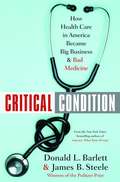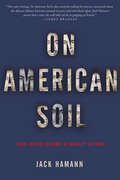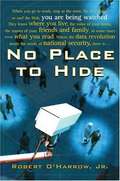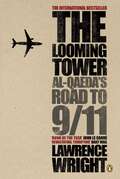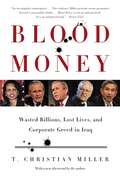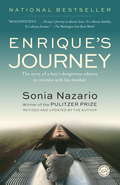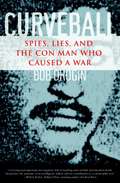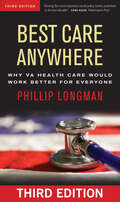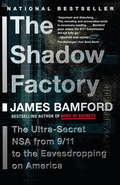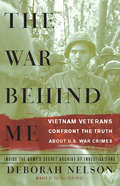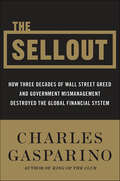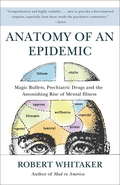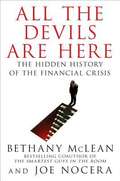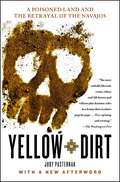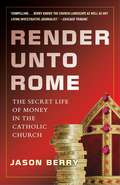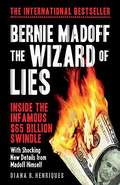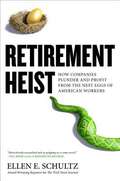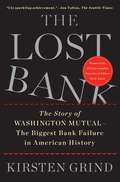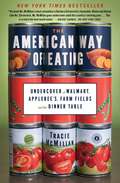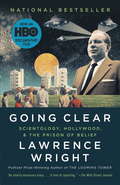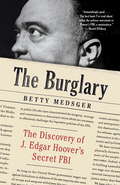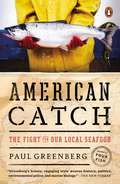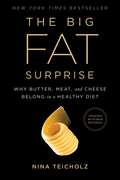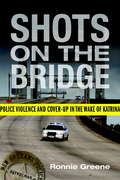Special Collections
Investigative Reporters and Editors Award
Description: The annual IRE Awards recognize outstanding investigative work and help identify the techniques and resources used to complete each story. This collection includes award winners and finalists. #award
- Table View
- List View
Critical Condition
by Donald L. Barlett and James B. SteeleExposing the most controversial, little-known practices of America’s most flawed system, Time magazine’s Pulitzer Prize-winning investigative team pulls back the curtain on the health care industry to explain exactly how things grew so out of control. Dirty examination and operating rooms in doctor’s offices and hospitals . . . Health care executives pulling in millions in bonuses for denying treatment to the sick . . . More than 100 million people with inadequate or no medical coverage . . . This may sound like the predicament of a third-world nation, but this is America’s health care reality today. The U. S. spends more on health care than any other nation, yet our benefits are shrinking and life expectancy is shorter here than in countries that spend significantly less per capita. Meanwhile, HMOs, pharmaceutical companies, and hospital chains reap tremendous profits, while politicians—beholden to insurers and drug companies—enact legislation for the benefit of the few rather than the many, while the entire system is on the verge of collapse. In CRITICAL CONDITION, award-winning investigative journalists Donald L. Barlett and James B. Steele expose the horror of what health care in America has become. They profile patients and doctors trapped by the system and offer startling personal stories that illuminate what’s gone wrong. Doctors tell of being second-guessed and undermined by health care insurers; nurses recount chilling tales of hospital meltdowns; patients explain how they’ve been victimized by a system that is meant to care for them. Drug companies profit by selling pills in the same manner that Madison Avenue sells soap, while Wall Street rakes in billions by building up and then tearing down health care businesses. And politicians pass legislation perpetuating the injustices and out-right fraud the system encourages. By analyzing the industry and offering an insightful prescription for getting it back on the right track, CRITICAL CONDITION is an enormously compelling investigative work that addresses the concerns of every American.
On American Soil
by Jack HamannOn a hot August night in 1944, a soldier’s body was discovered hanging by a rope from a cable spanning an obstacle course at Seattle’s Fort Lawton. The body was identified as Private Guglielmo Olivotto, one of the thousands of Italian prisoners of war captured and brought to America. The murder stunned the nation and the international community. Under pressure to respond quickly, the War Department convened a criminal trial at the fort, charging three African American soldiers with the lynching and firstdegree murder of Private Olivotto. Forty other soldiers were charged with rioting, accused of storming the Italian barracks on the night of the murder. All forty-three soldiers were black. There was no evidence implicating any of these men. Leon Jaworski, later the lead prosecuter at the Watergate trial, was appointed to prosecute the case and seek the death penalty for three men who were most assuredly innocent. Through his access to previously classified documents and the information gained from extensive interviews, journalist Jack Hamann tells the whole story behind World War II’s largest army court-martial—a story that raises important questions about how justice is carried out when a country is at war.
No Place to Hide
by Robert O'Harrow Jr.An award-winning reporter for The Washington Post, O'Harrow reviews some of the surveillance and identification technologies and procedures now being used by corporations and governments against the American people. He begins with the flood of measures adopted during the six weeks after the September 2001 attacks. Other topics include the data revolution, Total Information Awareness, and the government's eyes and ears. Annotation ©2007 Book News, Inc., Portland, OR (booknews.com)
The Looming Tower
by Lawrence WrightTHE PULITZER PRIZE-WINNING BESTSELLER, NOW A MAJOR NEW TV SERIESThis is the definitive account of the run-up to 9/11: from the man who lit the spark of radical Islam in 1948, to those who built up a terror network, and to the FBI agent whose warnings of 'something big' coming were ignored until the Twin Towers fell.'The Looming Tower is a thriller. And it's a tragedy, too' The New York Times'The most detailed (and thrilling) account we have of the events that led to the destruction of the Twin Towers' Observer, Books of the Year'Possibly the best book yet written on the rise of al-Qaeda ... beautifully written and wonderfully compelling' William Dalrymple'We meet some formidable schemers and killers ... fabulists crazed with blood and death' Martin Amis
Blood Money
by T. Christian MillerIt was supposed to be quick and easy. The Bush Administration even promised that it wouldn't cost American taxpayers a thing--Iraqi oil revenues would pay for it all. But billions and billions of dollars, and thousands of lives, later, the Iraqi reconstruction is an undeniable failure. Iraq pumps out less oil now than it did under Saddam. At best, Iraqis average all of twelve hours a day of electricity. American soldiers lack body armor and adequate protection for their motor vehicles. Increasingly worse off, Iraqis turn against us. Increasingly worse off, our troops are killed by a strengthening insurgency. As T. Christian Miller reveals in this searing and timely book, the Bush Administration has fatally undermined the war effort and our soldiers by handing out mountains of cash not to the best companies for the reconstruction effort, but to buddies, cronies, relatives and political hacks--some of whom have simply taken the money and run with it. Blistering, brilliant and shocking, this will be the breakout title when it comes to Iraq books, and the catalyst for national debate.
Enrique's Journey
by Sonia NazarioIn this astonishing true story, award-winning journalist Sonia Nazario recounts the unforgettable odyssey of a Honduran boy who braves unimaginable hardship and peril to reach his mother in the United States.
When Enrique is five years old, his mother, Lourdes, too poor to feed her children, leaves Honduras to work in the United States.
The move allows her to send money back home to Enrique so he can eat better and go to school past the third grade. Lourdes promises Enrique she will return quickly. But she struggles in America. Years pass. He begs for his mother to come back. Without her, he becomes lonely and troubled. When she calls, Lourdes tells him to be patient. Enrique despairs of ever seeing her again.
After eleven years apart, he decides he will go find her. Enrique sets off alone from Tegucigalpa, with little more than a slip of paper bearing his mother's North Carolina telephone number. Without money, he will make the dangerous and illegal trek up the length of Mexico the only way he can-clinging to the sides and tops of freight trains. With gritty determination and a deep longing to be by his mother's side, Enrique travels through hostile, unknown worlds.
Each step of the way through Mexico, he and other migrants, many of them children, are hunted like animals. Gangsters control the tops of the trains. Bandits rob and kill migrants up and down the tracks. Corrupt cops all along the route are out to fleece and deport them. To evade Mexican police and immigration authorities, they must jump onto and off the moving boxcars they call El Tren de la Muerte--The Train of Death.
Enrique pushes forward using his wit, courage, and hope-and the kindness of strangers. It is an epic journey, one thousands of immigrant children make each year to find their mothers in the United States.
Based on the Los Angeles Times newspaper series that won two Pulitzer Prizes, one for feature writing and another for feature photography, Enrique's Journey is the timeless story of families torn apart, the yearning to be together again, and a boy who will risk his life to find the mother he loves.
Curveball
by Bob DroginCurveball answers the crucial question of the Iraq war: How and why was America's intelligence so catastrophically wrong? In this dramatic and explosive book, award-winning Los Angeles Times reporter Bob Drogin delivers a narrative that takes us to Europe, the Middle East, and deep inside the CIA to find the truth about the lies and self-deception that led us into a military and political nightmare.
Best Care Anywhere
by Phillip LongmanNEW EDITION, REVISED AND UPDATED Phillip Longman tells the amazing story of the turnaround of the Department of Veterans Affairs health-care system from a dysfunctional, scandal-prone bureaucracy into the benchmark for high-quality medicine in the United States. Best Care Anywhere shows that vast swaths of what we think we know about health, health care, and medical economics are just plain wrong. And the book demonstrates how this extraordinarily cost-effective model, which has proven to be highly popular with veterans, can be made available to everyone. New to this edition is an analysis of how the shortcomings of both so-called Obamacare and Republican plans to privatize Medicare reinforce the need for applying the lessons of the VA. Also included are completely updated statistics and research, as well as examples of how the private sector is already beginning to learn from the VA’s example.
Exposed
by Mark SchapiroThe United States was once the pioneer of new approaches to environmental protection. In the 1970s and 1980s an American mix of scientific rigor and legal muscle gave birth to a body of environmental regulations and laws that was seen as a model around the world. But no more; leadership has switched. The European Union is asserting new priorities that are far more protective of citizens' health and the environment than those in the United States and they have the economic muscle to back them up.
The Shadow Factory
by James BamfordJames Bamford has been the preeminent expert on the National Security Agency since his reporting revealed the agency’s existence in the 1980s. Now Bamford describes the transformation of the NSA since 9/11, as the agency increasingly turns its high-tech ears on the American public. The Shadow Factoryreconstructs how the NSA missed a chance to thwart the 9/11 hijackers and details how this mistake has led to a heightening of domestic surveillance. In disturbing detail, Bamford describes exactly how every American’s data is being mined and what is being done with it. Any reader who thinks America’s liberties are being protected by Congress will be shocked and appalled at what is revealed here.
The War Behind Me
by Deborah NelsonA seasoned journalist uncovers a secret archive of hundreds of war crime investigations, tracks down the people involved, and emerges with a disturbing and revelatory story of what really happened in Vietnam.
The Sellout
by Charles GasparinoIn the spirit of Barbarians at the Gate and Liar’s Poker comes The Sellout, the definitive book on the recent collapse of Wall Street, one of the most dramatic and anxiety-ridden era in national socioeconomic history. In this powerful business narrative, Charles Gasparino, the author of Blood on the Floor and King of the Club, captures how avarice, arrogance, and sheer stupidity eroded Wall Street’s dominance, made many of our country’s most fabled financial institutions vulnerable to significant new foreign control, and profoundly weakened the financial security of millions of poor and middle-class American families.
Anatomy of an Epidemic
by Robert WhitakerIn this astonishing and startling book, award-winning science and history writer Robert Whitaker investigates a medical mystery: Why has the number of disabled mentally ill in the United States tripled over the past two decades? Every day, 1,100 adults and children are added to the government disability rolls because they have become newly disabled by mental illness, with this epidemic spreading most rapidly among our nation’s children. What is going on?
Anatomy of an Epidemic challenges readers to think through that question themselves. First, Whitaker investigates what is known today about the biological causes of mental disorders. Do psychiatric medications fix “chemical imbalances” in the brain, or do they, in fact, create them? Researchers spent decades studying that question, and by the late 1980s, they had their answer. Readers will be startled—and dismayed—to discover what was reported in the scientific journals.
Then comes the scientific query at the heart of this book: During the past fifty years, when investigators looked at how psychiatric drugs affected long-term outcomes, what did they find? Did they discover that the drugs help people stay well? Function better? Enjoy good physical health? Or did they find that these medications, for some paradoxical reason, increase the likelihood that people will become chronically ill, less able to function well, more prone to physical illness?
This is the first book to look at the merits of psychiatric medications through the prism of long-term results. Are long-term recovery rates higher for medicated or unmedicated schizophrenia patients? Does taking an antidepressant decrease or increase the risk that a depressed person will become disabled by the disorder? Do bipolar patients fare better today than they did forty years ago, or much worse? When the National Institute of Mental Health (NIMH) studied the long-term outcomes of children with ADHD, did they determine that stimulants provide any benefit?
By the end of this review of the outcomes literature, readers are certain to have a haunting question of their own: Why have the results from these long-term studies—all of which point to the same startling conclusion—been kept from the public?
In this compelling history, Whitaker also tells the personal stories of children and adults swept up in this epidemic. Finally, he reports on innovative programs of psychiatric care in Europe and the United States that are producing good long-term outcomes. Our nation has been hit by an epidemic of disabling mental illness, and yet, as Anatomy of an Epidemic reveals, the medical blueprints for curbing that epidemic have already been drawn up.
All the Devils Are Here
by Bethany Mclean and Joe Nocera"Hell is empty, and all the devils are here." -Shakespeare, The TempestAs soon as the financial crisis erupted, the finger-pointing began. Should the blame fall on Wall Street, Main Street, or Pennsylvania Avenue? On greedy traders, misguided regulators, sleazy subprime companies, cowardly legislators, or clueless home buyers?According to Bethany McLean and Joe Nocera, two of America's most acclaimed business journalists, the real answer is all of the above-and more. Many devils helped bring hell to the economy. And the full story, in all of its complexity and detail, is like the legend of the blind men and the elephant. Almost everyone has missed the big picture. Almost no one has put all the pieces together.All the Devils Are Here goes back several decades to weave the hidden history of the financial crisis in a way no previous book has done. It explores the motivations of everyone from famous CEOs, cabinet secretaries, and politicians to anonymous lenders, borrowers, analysts, and Wall Street traders. It delves into the powerful American mythology of homeownership. And it proves that the crisis ultimately wasn't about finance at all; it was about human nature.Among the devils you'll meet in vivid detail:* Angelo Mozilo, the CEO of Countrywide, who dreamed of spreading homeownership to the masses, only to succumb to the peer pressure-and the outsized profits-of the sleaziest subprime lending.* Roland Arnall, a respected philanthropist and diplomat, who made his fortune building Ameriquest, a subprime lending empire that relied on blatantly deceptive lending practices.* Hank Greenberg, who built AIG into a Rube Goldberg contraption with an undeserved triple-A rating, and who ran it so tightly that he was the only one who knew where all the bodies were buried.* Stan O'Neal of Merrill Lynch, aloof and suspicious, who suffered from "Goldman envy" and drove a proud old firm into the ground by promoting cronies and pushing out his smartest lieutenants.* Lloyd Blankfein, who helped turn Goldman Sachs from a culture that famously put clients first to one that made clients secondary to its own bottom line.* Franklin Raines of Fannie Mae, who (like his predecessors) bullied regulators into submission and let his firm drift away from its original, noble mission.* Brian Clarkson of Moody's, who aggressively pushed to increase his rating agency's market share and stock price, at the cost of its integrity.* Alan Greenspan, the legendary maestro of the Federal Reserve, who ignored the evidence of a growing housing bubble and turned a blind eye to the lending practices that ultimately brought down Wall Street-and inflicted enormous pain on the country.Just as McLean's The Smartest Guys in the Room was hailed as the best Enron book on a crowded shelf, so will All the Devils Are Here be remembered for finally making sense of the meltdown and its consequences.
Yellow Dirt
by Judy PasternakWINNER OF THE J. ANTHONY LUKAS WORK-IN-PROGRESS AWARD Atop a craggy mesa in the northern reaches of the Navajo reservation lies what was once a world-class uranium mine called Monument No. 2. Discovered in the 1940s--during the government's desperate press to build nuclear weapons--the mesa's tremendous lode would forever change the lives of the hundreds of Native Americans who labored there and of their families, including many who dwelled in the valley below for generations afterward. Yellow Dirt offers readers a window into a dark chapter of modern history that still reverberates today. From the 1940s into the early twenty-first century, the United States knowingly used and discarded an entire tribe for the sake of atomic bombs. Secretly, during the days of the Manhattan Project and then in a frenzy during the Cold War, the government bought up all the uranium that could be mined from the hundreds of rich deposits entombed under the sagebrush plains and sandstone cliffs. Despite warnings from physicians and scientists that long-term exposure could be harmful, even fatal, thousands of miners would work there unprotected. A second set of warnings emerged about the environmental impact. Yet even now, long after the uranium boom ended, and long after national security could be cited as a consideration, many residents are still surrounded by contaminated air, water, and soil. The radioactive "yellow dirt" has ended up in their drinking supplies, in their walls and floors, in their playgrounds, in their bread ovens, in their churches, and even in their garbage dumps. And they are still dying. Transporting readers into a little-known country-within-a-country, award-winning journalist Judy Pasternak gives rare voice to Navajo perceptions of the world, their own complicated involvement with uranium mining, and their political coming-of-age. Along the way, their fates intertwine with decisions made in Washington, D.C., in the Navajo capital of Window Rock, and in the Western border towns where swashbuckling mining men trained their sights on the fortunes they could wrest from tribal land, successfully pressuring the government into letting them do it their way. Yellow Dirt powerfully chronicles both a scandal of neglect and the Navajos' long fight for justice. Few had heard of this shameful legacy until Pasternak revealed it in a prize-winning Los Angeles Times series that galvanized a powerful congressman and a famous prosecutor to press for redress and repair of the grievous damage. In this expanded account, she provides gripping new details, weaving the personal and the political into a tale of betrayal, of willful negligence, and, ultimately, of reckoning.
Render Unto Rome
by Jason BerryAN INVESTIGATION OF EPIC FINANCIAL INTRIGUE, RENDER UNTO ROME EXPOSES THE SECRECY AND DECEIT THAT RUN COUNTER TO THE VALUES OF THE CATHOLIC CHURCH.The Sunday collection in every Catholic church throughout the world is as familiar a part of the Mass as the homily and even Communion. There is no doubt that historically the Catholic Church has been one of the great engines of charity in history. But once a dollar is dropped in that basket, where does it go? How are weekly cash contributions that can amount to tens of thousands of dollars accounted for? Where does the money go when a diocese sells a church property for tens of millions of dollars? And what happens when hundreds of millions of dollars are turned over to officials at the highest ranks, no questions asked, for their discretionary use? The Roman Catholic Church is the largest organization in the world. The Vatican has never revealed its net worth, but the value of its works of art, great churches, property in Rome, and stocks held through its bank easily run into the tens of billions. Yet the Holy See as a sovereign state covers a mere 108 acres and has a small annual budget of about $280 million.No major book has examined the church's financial underpinnings and practices with such journalistic force. Today the church bears scrutiny by virtue of the vast amounts of money (nearly $2 billion in the United States alone) paid out to victims of clergy abuse. Amid mounting diocesan bankruptcies, bishops have been selling off whole pieces of the infrastructure--churches, schools, commercial properties--while the nephew of one of the Vatican's most powerful cardinals engaged in a lucrative scheme to profiteer off the enormous downsizing of American church wealth.From the Hardcover edition.
Bernie Madoff, the Wizard of Lies
by Diana B. HenriquesBased on award-winning reporter Diana Henriques' unprecedented access to Madoff, including extensive correspondence and his first interviews for publication since his arrest, "Bernie Madoff, The Wizard of Lies" is the ultimate true-life financial thriller.
Retirement Heist
by Ellen E. SchultzIt's no secret that hundreds of companies have been slashing pensions and health coverage earned by millions of retirees. Employers blame an aging workforce, stock market losses, and spiraling costs-a perfect storm of external forces that has forced them to take drastic measures. But this so-called retirement crisis is no accident. Award-winning investigative reporter Ellen E. Schultz reveals how large companies and the retirement industry-benefits consultants, insurance companies, and banks-have all played a huge, hidden role in the death spiral of American pensions and benefits. A little over a decade ago, most companies had more than enough set aside to pay the benefits earned by two generations of workers, no matter how long they lived. But by exploiting loopholes, ambiguous regulations, and new accounting rules, companies essentially turned their pension plans into piggy banks, tax shelters, and profit centers. Drawing on original analysis of company data, government filings, confidential memos, and more, Schultz uncovers decades of deception during which employers have exaggerated their retiree burdens while lobbying for government handouts, secretly cutting pensions, tricking employees, and misleading shareholders. She reveals how companies siphon billions of dollars from their pension plans to finance downsizings and sell the assets in merger deals; overstate the burden of rank-and-file retiree obligations to justify benefits cuts while using the savings to inflate executive pay and pensions; hide their growing executive pension liabilities, which at some companies now exceed the liabilities for the regular pension plans; purchase billions of dollars of life insurance on workers and use the policies as informal executive pension funds; preemptively sue retirees after cutting retiree health benefits and use other legal strategies to erode their legal protections. This is a scathing exposé of one of the most critical and least understood crises of our time.
The Lost Bank
by Kirsten GrindDuring the most dizzying days of the financial crisis, Washington Mutual, a bank with hundreds of billions of dollars in its coffers, suffered a crippling bank run. The story of its final, brutal collapse in the autumn of 2008, and its controversial sale to JPMorgan Chase, is an astonishing account of how one bank lost itself to greed and mismanagement, and how the entire financial industry--and even the entire country-- lost its way as well. Kirsten Grind's The Lost Bank is a magisterial and gripping account of these events, tracing the cultural shifts, the cockamamie financial engineering, and the hubris and avarice that made this incredible story possible. The men and women who become the central players in this tragedy-- the regulators and the bankers, the home buyers and the lenders, the number crunchers and the shareholders--are heroes and villains, perpetrators and victims, often switching roles with one another as the drama unfolds. As a reporter at the time for the Puget Sound Business Journal, Grind covered a story set far from the epicenters of finance and media. It happened largely in places such as the suburban homes of central California and the office buildings of Seattle, but Grind covered the story from the beginning, and the clarity and persistence of her reporting earned her many awards, including being named a finalist for the Pulitzer Prize and the Gerald Loeb Award. She takes readers into boardrooms and bedrooms, revealing the power struggles that pitted regulators at the Office of Thrift Supervision and the FDIC against one another and the predatory negotiations of investment bankers and lawyers who enriched themselves during the bank's rise and then devoured the decimated bank in its final days. Written as compellingly as the finest fiction, The Lost Bank makes it clear that the collapse of Washington Mutual was not just the largest bank failure in American history. It is a story of talismanic qualities, reflecting the incredible rise and the precipitous collapse of not only an institution but of trust, fortunes, and the marketplaces for risk across the world.
The American Way of Eating
by Tracie McmillanWhat if you can't afford nine-dollar tomatoes? That was the question award-winning journalist Tracie McMillan couldn't escape as she watched the debate about America's meals unfold, one that urges us to pay food's true cost--which is to say, pay more. So in 2009 McMillan embarked on a groundbreaking undercover journey to see what it takes to eat well in America. For nearly a year, she worked, ate, and lived alongside the working poor to examine how Americans eat when price matters. From the fields of California, a Walmart produce aisle outside of Detroit, and the kitchen of a New York City Applebee's, McMillan takes us into the heart of America's meals. With startling intimacy she portrays the lives and food of Mexican garlic crews, Midwestern produce managers, and Caribbean line cooks, while also chronicling her own attempts to live and eat on meager wages. Along the way, she asked the questions still facing America a decade after the declaration of an obesity epidemic: Why do we eat the way we do? And how can we change it? To find out, McMillan goes beyond the food on her plate to examine the national prio-rities that put it there. With her absorbing blend of riveting narrative and formidable investigative reporting, McMillan takes us from dusty fields to clanging restaurant kitchens, linking her work to the quality of our meals--and always placing her observations in the context of America's approach not just to farms and kitchens but to wages and work. The surprising answers that McMillan found on her journey have profound implications for our food and agriculture, and also for how we see ourselves as a nation. Through stunning reportage, Tracie McMillan makes the simple case that--city or country, rich or poor--everyone wants good food. Fearlessly reported and beautifully written, The American Way of Eating goes beyond statistics and culture wars to deliver a book that is fiercely intelligent and compulsively readable. Talking about dinner will never be the same again.
Going Clear
by Lawrence WrightA clear-sighted revelation, a deep penetration into the world of Scientology by the Pulitzer Prize-winning author of The Looming Tower, the now-classic study of al-Qaeda's 9/11 attack. Based on more than two hundred personal interviews with current and former Scientologists--both famous and less well known--and years of archival research, Lawrence Wright uses his extraordinary investigative ability to uncover for us the inner workings of the Church of Scientology.At the book's center, two men whom Wright brings vividly to life, showing how they have made Scientology what it is today: The darkly brilliant science-fiction writer L. Ron Hubbard, whose restless, expansive mind invented a new religion. And his successor, David Miscavige--tough and driven, with the unenviable task of preserving the church after the death of Hubbard.We learn about Scientology's complicated cosmology and special language. We see the ways in which the church pursues celebrities, such as Tom Cruise and John Travolta, and how such stars are used to advance the church's goals. And we meet the young idealists who have joined the Sea Org, the church's clergy, signing up with a billion-year contract.In Going Clear, Wright examines what fundamentally makes a religion a religion, and whether Scientology is, in fact, deserving of this constitutional protection. Employing all his exceptional journalistic skills of observation, understanding, and shaping a story into a compelling narrative, Lawrence Wright has given us an evenhanded yet keenly incisive book that reveals the very essence of what makes Scientology the institution it is.From the Hardcover edition.
The Burglary
by Betty MedsgerThe never-before-told full story of the 1971 history-changing break-in of the FBI offices in Media, Pennsylvania, by a group of unlikely activists--quiet, ordinary, hardworking Americans--that made clear the shocking truth and confirmed what some had long suspected, that J. Edgar Hoover had created and was operating his own shadow Bureau of Investigation.The book shows how the break-in, and subsequent release of the contents of the FBI's files to newspapers across the country, upended the public's perception of the up-till-then inviolate head of the Bureau, paving the way for the FBI's overhaul for the first time since its inception forty-seven years before, in 1924, and setting the stage for the sensational release three months later by Daniel Ellsberg of the top-secret seven-thousand-page Pentagon study of U.S. decision making regarding the Vietnam War that became known as the Pentagon Papers.
American Catch
by Paul GreenbergINVESTIGATIVE REPORTERS & EDITORS Book Award, Finalist 2014
In American Catch, award-winning author Paul Greenberg takes the same skills that won him acclaim in Four Fish to uncover the tragic unraveling of the nation's seafood supply--telling the surprising story of why Americans stopped eating from their own waters. In 2005, the United States imported five billion pounds of seafood, nearly double what we imported twenty years earlier. Bizarrely, during that same period, our seafood exports quadrupled.
American Catch examines New York oysters, Gulf shrimp, and Alaskan salmon to reveal how it came to be that 91 percent of the seafood Americans eat is foreign. In the 1920s, the average New Yorker ate six hundred local oysters a year. Today, the only edible oysters lie outside city limits. Following the trail of environmental desecration, Greenberg comes to view the New York City oyster as a reminder of what is lost when local waters are not valued as a food source. Farther south, a different catastrophe threatens another seafood-rich environment.
When Greenberg visits the Gulf of Mexico, he arrives expecting to learn of the Deepwater Horizon oil spill's lingering effects on shrimpers, but instead finds that the more immediate threat to business comes from overseas. Asian-farmed shrimp--cheap, abundant, and a perfect vehicle for the frying and sauces Americans love--have flooded the American market. Finally, Greenberg visits Bristol Bay, Alaska, home to the biggest wild sockeye salmon run left in the world. A pristine, productive fishery, Bristol Bay is now at great risk: The proposed Pebble Mine project could under¬mine the very spawning grounds that make this great run possible. In his search to discover why this precious renewable resource isn't better protected, Green¬berg encounters a shocking truth: the great majority of Alaskan salmon is sent out of the country, much of it to Asia. Sockeye salmon is one of the most nutritionally dense animal proteins on the planet, yet Americans are shipping it abroad.
Despite the challenges, hope abounds. In New York, Greenberg connects an oyster restoration project with a vision for how the bivalves might save the city from rising tides. In the Gulf, shrimpers band together to offer local catch direct to consumers. And in Bristol Bay, fishermen, environmentalists, and local Alaskans gather to roadblock Pebble Mine. With American Catch, Paul Greenberg proposes a way to break the current destructive patterns of consumption and return American catch back to American eaters.
The Big Fat Surprise
by Nina TeicholzA New York Times bestseller Named one of The Economist's Books of the Year 2014 Named one of The Wall Street Journal's Top Ten Best Nonfiction Books of 2014 Kirkus Reviews Best Nonfiction Books of 2014 Forbes's Most Memorable Healthcare Book of 2014 In The Big Fat Surprise, investigative journalist Nina Teicholz reveals the unthinkable: that everything we thought we knew about dietary fat is wrong. She documents how the low-fat nutrition advice of the past sixty years has amounted to a vast uncontrolled experiment on the entire population, with disastrous consequences for our health.For decades, we have been told that the best possible diet involves cutting back on fat, especially saturated fat, and that if we are not getting healthier or thinner it must be because we are not trying hard enough. But what if the low-fat diet is itself the problem? What if the very foods we've been denying ourselves--the creamy cheeses, the sizzling steaks--are themselves the key to reversing the epidemics of obesity, diabetes, and heart disease? In this captivating, vibrant, and convincing narrative, based on a nine-year-long investigation, Teicholz shows how the misinformation about saturated fats took hold in the scientific community and the public imagination, and how recent findings have overturned these beliefs. She explains why the Mediterranean Diet is not the healthiest, and how we might be replacing trans fats with something even worse. This startling history demonstrates how nutrition science has gotten it so wrong: how overzealous researchers, through a combination of ego, bias, and premature institutional consensus, have allowed dangerous misrepresentations to become dietary dogma. With eye-opening scientific rigor, The Big Fat Surprise upends the conventional wisdom about all fats with the groundbreaking claim that more, not less, dietary fat--including saturated fat--is what leads to better health and wellness. Science shows that we have been needlessly avoiding meat, cheese, whole milk, and eggs for decades and that we can now, guilt-free, welcome these delicious foods back into our lives.
Shots on the Bridge
by Ronnie GreeneA harrowing story of blue on black violence, of black lives that seemingly did not matter.On September 4, 2005, six days after Hurricane Katrina's landfall in New Orleans, two groups of people intersected on the Danziger Bridge, a low-rising expanse over the Industrial Canal. One was the police who had stayed behind as Katrina roared near, desperate to maintain control as their city spun into chaos. The other was the residents forced to stay behind with them during the storm and, on that fateful Sunday, searching for the basics of survival: food, medicine, security. They collided that morning in a frenzy of gunfire.When the shooting stopped, a gentle forty-year-old man with the mind of a child lay slumped on the ground, seven bullet wounds in his back, his white shirt turned red. A seventeen-year-old was riddled with gunfire from his heel to his head. A mother's arm was blown off; her daughter's stomach gouged by a bullet. Her husband's head was pierced by shrapnel. Her nephew was shot in the neck, jaw, stomach, and hand. Like all the other victims, he was black--and unarmed.Before the blood had dried on the pavement, the shooters, each a member of the New Orleans Police Department, and their supervisors hatched a cover-up. They planted a gun, invented witnesses, and charged two of their victims with attempted murder. At the NOPD, they were hailed as heroes. Shots on the Bridge explores one of the most dramatic cases of police violence seen in our country in the last decade--the massacre of innocent people, carried out by members of the NOPD, in the brutal, disorderly days following Hurricane Katrina. It reveals the fear that gripped the police of a city slid into anarchy, the circumstances that drove desperate survivors to the bridge, and the horror that erupted when the police opened fire. It carefully unearths the cover-up that nearly buried the truth. And finally, it traces the legal maze that, a decade later, leaves the victims and their loved ones still searching for justice. This is the story of how the people meant to protect and serve citizens can do violence, hide their tracks, and work the legal system as the nation awaits justice.From the Hardcover edition.
